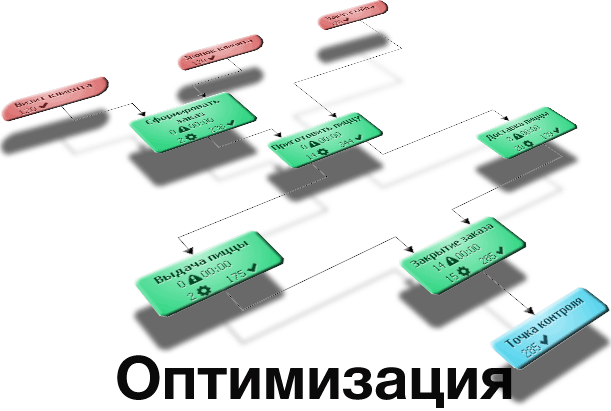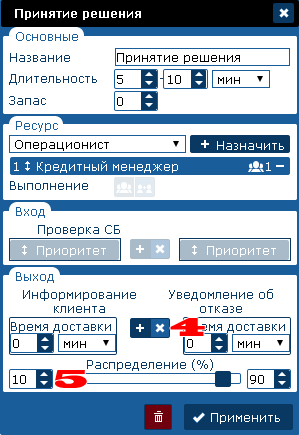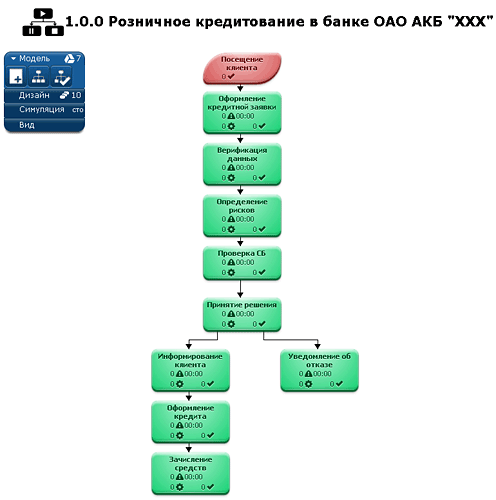We optimize the business process using a simulator
Process optimization is not easy. In the middle of the two thousandth, it was even forbidden to mention this word as being compromised by the implication of useless activity. Until now, people try to use synonyms such as reengineering, improvement, performance, etc. Nevertheless, improving efficiency is one of the goals of business process management. The basis for optimization is the result of the analysis of data on the environment and content of the process. If there is no possibility of collecting statistical data (for example, when designing a new process), they are generated by the BP simulators.
In one of the previous posts on Habré, I talked about the online service of business process simulation simulation bpsimulator.com. Today we will try with its help to solve a specific task to improve the efficiency of work, for example, the process of retail lending to a bank.
One of the mistakes is to start optimization for the sake of optimization, but we are like that, we have an introductory one: a sales point of a competing bank offering a similar product has opened near the bank branch. Technology and product can not be changed, it is necessary to reduce the time from the moment of filing an application to the issuance of a loan to form a competitive advantage.

First you need to collect data on the necessary functions, their sequence and performers:
Feature list
1. “Making a loan application” is performed by the “Cash Operator” in 15-30 minutes
2. "Data Verification" performs the "Verifier" for 5-15 minutes
3. “Risk Identification” performs “Scoring (automatically)” for 1 minute
4. "Security check" is performed by "Security Officer" for 10-15 minutes
5 “Decision Making” is performed by the “Credit Manager” for 5-10 minutes, Approval Rate (Approval Rate) AR = 0.1
6. "Informing the client" is performed by the "Call Center Operator" in 5 minutes
7. “Notification of rejection” performs “SMS gateway (automatically)” in 30 seconds
8. “Loan processing” is performed by the “Operator” in 10-20 minutes
9. "Deposit of funds" performs "ABS (automatically)" for 1 minute
Composition of organizational structures
1. Operator: 2 employees in 10 sub-offices
2. Verifier: 6 employees in the branch
3. Security Officer: 10 employees in the branch
4. Credit Manager: 5 branch employees
5. Operator KC: 2 employees KC
External factors
1.The average number of visitors per day is 32 visitors, evenly throughout the working day.
We go to the service, run the application and select the Russian language and the creation of a new model. Clicking the right mouse button on the name, we change it to “1.0.0 Retail lending in the Bank JSCB“ XXX ”.
The only thing that is still in the workspace is the control panel with sections: Model, Design, Simulation and View. In the Design section, we click „Add generator“ - this is a task generator, in our case it is a generator of bank visitors wishing to apply for a loan. Nearby is also the button “Add function”, we will need them 9. Place the mouse on these objects on the model from top to bottom.
Each object has an “entrance” - the upper part and an “exit” - the lower part. To connect objects, click on "+" in the area of "exit" of the superior object and then on "+" of the subordinate (or any other). So there will be a connection with the arrow from the exit of one object to the entrance of another.

Double-clicking on an object opens its properties window. There it is necessary to change the default values for the data that we have collected about the process.

To change the position of the executor, double click on the line with the resource (marked with 3 in the figure). The resource manager window will open. The job title should be changed and click on the “Save resource” checkbox in the same place, then the name will change in all functions where this specialist is involved. For the function “Making a loan” in the drop-down list, select the already created “Operator” and delete the extra line. At the end of the simulation, the “Resource Management” window looks like this (I deleted one unused automatically created position):

The “Decision making” function should have two exits, one to the “Information” function, and the second to the “Failure notification”. Thus, at the output of this function, a rule of process distribution is formed, a logical “OR” (or a positive decision will be made on the loan and the client should be invited to the office -10%, or it will be enough to inform the client about the negative decision -90%). The function properties should look like this:

The generator will be called “Customer request”, in the section “Working time”, double-clicking on the line “09: 00-18: 00” you can edit the number of customers during the working day.
At this stage of the simulation usually ends, our model is as follows:

The model will be tested for correctness, but does not pass the test for adequacy. Our branch office middle office serves applications for 9 more departments, and this must be modeled to obtain adequate results.
Let's add one more task generator with the name “Making an application in another TO” and the number of tasks 32 * 9 = 288 during the working day. The output of the generator is given to the input of the function “Data Verification”. Between informing the client and processing the loan, you need to put a filter so that the applications of the second generator do not go to one branch. Put the “Point of Control” object between them from the “Design” section and, in its properties, click the “Allow” generator with the name “Customer's address” - then only those applications that this operator did will go through. The final model is:

Now you can run.
On the toolbar in the “Simulation” section, click “Start” - the simulation will start, the numbers on the model objects will reflect the state of the process on a time scale of 1 second of real time equal to 1 minute of the process time. The simulation will stop after a day of process time, i.e. in 24 minutes of real. This is a long time, so you can press the next button "Speed up" - then the calculation of the day will take just 24 seconds. At the end of the simulation, we will collect all the data on the state of the process, tasks, functions and workload of employees during the entire simulation period.
In the “View” section of the toolbar there is a button for opening the “Statistics” window, in it in tabs are located the graphs of the process status. Since we have a goal to reduce the time for completing tasks, we look at the “Tasks” tab:

average operating time is about an hour. This value we will need to somehow reduce. The first thing that comes to mind is to increase the number of employees in the most loaded sections. On the tab „Person. resources “it is clear that verifiers are working at the limit of their strength.
')

In the “View” section of the toolbar there is a button “Resources” of opening the window “Resource Manager”, we will increase the number of verifiers from 6 to 8 people (do not forget to press the tick of resource saving)

The operational time of work on the tasks practically did not change, but the verifiers had too much free time. So you need to dig in another direction, for example, at the time of the execution of the critical function. The “Data Verification” function has a maximum execution time of 15 minutes, three times the minimum 5 minutes. But what if we can reduce the maximum verification time to 10 minutes? To test the hypothesis, let us return the number of verifiers -6, and set the time for performing the “Data Verification” function to 6-10 minutes. Run the simulation.

The operating time decreased by 15 minutes, i.e. by 25%, and on some runs this result reaches 50%, which is the fact that it makes sense to carry out further optimization at the level of a specific function.
As you can see, easily accessible data, simple tools and non-professional qualifications are enough to start using and obtaining practical results of simulation. Everyone will be able to solve their problems of optimizing business processes, testing hypotheses for making changes, and rationing the number of personnel. If you are interested in what the other function settings fields are for and in what cases they need to be used, you can look at the service help guide , and I will be happy to ask questions and wishes in the comments.
In one of the previous posts on Habré, I talked about the online service of business process simulation simulation bpsimulator.com. Today we will try with its help to solve a specific task to improve the efficiency of work, for example, the process of retail lending to a bank.
Optimization goal
One of the mistakes is to start optimization for the sake of optimization, but we are like that, we have an introductory one: a sales point of a competing bank offering a similar product has opened near the bank branch. Technology and product can not be changed, it is necessary to reduce the time from the moment of filing an application to the issuance of a loan to form a competitive advantage.

Business Process Data Collection
First you need to collect data on the necessary functions, their sequence and performers:
Feature list
1. “Making a loan application” is performed by the “Cash Operator” in 15-30 minutes
2. "Data Verification" performs the "Verifier" for 5-15 minutes
3. “Risk Identification” performs “Scoring (automatically)” for 1 minute
4. "Security check" is performed by "Security Officer" for 10-15 minutes
5 “Decision Making” is performed by the “Credit Manager” for 5-10 minutes, Approval Rate (Approval Rate) AR = 0.1
6. "Informing the client" is performed by the "Call Center Operator" in 5 minutes
7. “Notification of rejection” performs “SMS gateway (automatically)” in 30 seconds
8. “Loan processing” is performed by the “Operator” in 10-20 minutes
9. "Deposit of funds" performs "ABS (automatically)" for 1 minute
Composition of organizational structures
1. Operator: 2 employees in 10 sub-offices
2. Verifier: 6 employees in the branch
3. Security Officer: 10 employees in the branch
4. Credit Manager: 5 branch employees
5. Operator KC: 2 employees KC
External factors
1.The average number of visitors per day is 32 visitors, evenly throughout the working day.
Visitors do not walk evenly, the operations officer has a dozen more tasks for other processes, tasks are assigned to the verifier only once a day, AR depends on the product, the second operator collects on maternity leave, etc. This is extremely important for the next stage, but today we will learn from a simple example.
Visual business process modeling
We go to the service, run the application and select the Russian language and the creation of a new model. Clicking the right mouse button on the name, we change it to “1.0.0 Retail lending in the Bank JSCB“ XXX ”.
It will seem reasonable further when colleagues see the screen of your monitor.
The only thing that is still in the workspace is the control panel with sections: Model, Design, Simulation and View. In the Design section, we click „Add generator“ - this is a task generator, in our case it is a generator of bank visitors wishing to apply for a loan. Nearby is also the button “Add function”, we will need them 9. Place the mouse on these objects on the model from top to bottom.
Each object has an “entrance” - the upper part and an “exit” - the lower part. To connect objects, click on "+" in the area of "exit" of the superior object and then on "+" of the subordinate (or any other). So there will be a connection with the arrow from the exit of one object to the entrance of another.

Double-clicking on an object opens its properties window. There it is necessary to change the default values for the data that we have collected about the process.

To change the position of the executor, double click on the line with the resource (marked with 3 in the figure). The resource manager window will open. The job title should be changed and click on the “Save resource” checkbox in the same place, then the name will change in all functions where this specialist is involved. For the function “Making a loan” in the drop-down list, select the already created “Operator” and delete the extra line. At the end of the simulation, the “Resource Management” window looks like this (I deleted one unused automatically created position):

The “Decision making” function should have two exits, one to the “Information” function, and the second to the “Failure notification”. Thus, at the output of this function, a rule of process distribution is formed, a logical “OR” (or a positive decision will be made on the loan and the client should be invited to the office -10%, or it will be enough to inform the client about the negative decision -90%). The function properties should look like this:

The generator will be called “Customer request”, in the section “Working time”, double-clicking on the line “09: 00-18: 00” you can edit the number of customers during the working day.
At this stage of the simulation usually ends, our model is as follows:

The model will be tested for correctness, but does not pass the test for adequacy. Our branch office middle office serves applications for 9 more departments, and this must be modeled to obtain adequate results.
You can of course merge all cashiers into one abstract branch, but then if three visitors came to the office with two cashiers, the latter will queue for service, and in the abstract subsidiary office, a free specialist from another city will accept it. And if you divide the number of branch employees by the number of branches, it will be funny and not adequate.
It is possible to even duplicate the generators and the functions of the operator on the model 9 more times, it will turn out clearly, but cumbersome.
Let's add one more task generator with the name “Making an application in another TO” and the number of tasks 32 * 9 = 288 during the working day. The output of the generator is given to the input of the function “Data Verification”. Between informing the client and processing the loan, you need to put a filter so that the applications of the second generator do not go to one branch. Put the “Point of Control” object between them from the “Design” section and, in its properties, click the “Allow” generator with the name “Customer's address” - then only those applications that this operator did will go through. The final model is:

Now you can run.
Business process simulation
On the toolbar in the “Simulation” section, click “Start” - the simulation will start, the numbers on the model objects will reflect the state of the process on a time scale of 1 second of real time equal to 1 minute of the process time. The simulation will stop after a day of process time, i.e. in 24 minutes of real. This is a long time, so you can press the next button "Speed up" - then the calculation of the day will take just 24 seconds. At the end of the simulation, we will collect all the data on the state of the process, tasks, functions and workload of employees during the entire simulation period.
Business Process Analysis
In the “View” section of the toolbar there is a button for opening the “Statistics” window, in it in tabs are located the graphs of the process status. Since we have a goal to reduce the time for completing tasks, we look at the “Tasks” tab:

average operating time is about an hour. This value we will need to somehow reduce. The first thing that comes to mind is to increase the number of employees in the most loaded sections. On the tab „Person. resources “it is clear that verifiers are working at the limit of their strength.
')

In the “View” section of the toolbar there is a button “Resources” of opening the window “Resource Manager”, we will increase the number of verifiers from 6 to 8 people (do not forget to press the tick of resource saving)

The operational time of work on the tasks practically did not change, but the verifiers had too much free time. So you need to dig in another direction, for example, at the time of the execution of the critical function. The “Data Verification” function has a maximum execution time of 15 minutes, three times the minimum 5 minutes. But what if we can reduce the maximum verification time to 10 minutes? To test the hypothesis, let us return the number of verifiers -6, and set the time for performing the “Data Verification” function to 6-10 minutes. Run the simulation.

The operating time decreased by 15 minutes, i.e. by 25%, and on some runs this result reaches 50%, which is the fact that it makes sense to carry out further optimization at the level of a specific function.
Conclusion
As you can see, easily accessible data, simple tools and non-professional qualifications are enough to start using and obtaining practical results of simulation. Everyone will be able to solve their problems of optimizing business processes, testing hypotheses for making changes, and rationing the number of personnel. If you are interested in what the other function settings fields are for and in what cases they need to be used, you can look at the service help guide , and I will be happy to ask questions and wishes in the comments.
Source: https://habr.com/ru/post/219687/
All Articles